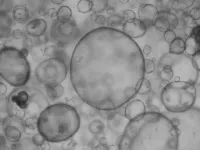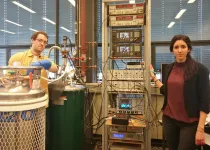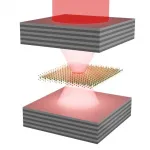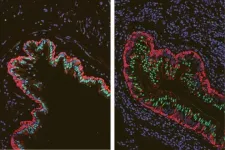To be or not to be: An organoid
Scientists publish first consensus on what is -- and what is not -- an organoid
2021-05-06
(Press-News.org) Mini-organs or organoids play a big role in the future of medicine. Their countless applications can help develop and implement tailored therapies for each patient. The revolutionary development of organoids started in Utrecht with a group of curious scientists. But when organoid research starting booming, confusion arose. What exactly is an organoid? Are there different types, and if so, what should they be called? A group of experts from around the world now publishes the first consensus on what is - and what is not - an organoid.
Bart Spee, Associate Professor at Utrecht University's faculty of Veterinary Medicine, is one of the initiators of the publication in Cell Stem Cell on May 6th. "Now that research into organoids is increasing, it is very important to have a clear definition and a coherent system to describe these cell structures. In the past, easy-to-grow cell lines have been put together in 3D and the resulting cell cluster was named an organoid. But according to our definition, it is not. Because such a cell line is not representative of all the differences between individuals that you also see in nature."
According to the new definition, an organoid must consist of primary cells which have been isolated from diseased or healthy tissues, for example, cancer cells from tumours. This provides a good representation of all the natural differences between individuals, and allows researchers to investigate whether certain therapies work for specific patient groups. That is simply not possible with standard cell lines. These are perfectly suitable for fundamental studies, but clinical applications ask for representative cell lines based on primary cells.
In the new system, different types of organoids are classified into one of three categories depending on defining characteristics. Spee explains: "Now you might hear things like 'a liver organoid', but the liver consists of several important cell types such as hepatocytes and bile duct cells (cholangiocytes). Therefore, it is important that researchers are specific when describing the organoid system they are culturing."
Future-proof
"Because new types of organoids will follow in the future, we have made our system future proof", says Luc van der Laan, Professor of Liver Regenerative Medicine at Erasmus MC. "And now that the first clinical application trials using organoids for organ repair are making their entrance, it is important to define precisely which organoid types are being used. Therefore, we developed a number of criteria to characterise future organoids. Our definition is based on organoids of cells of the liver, pancreas and bile ducts, but it is applicable to all tissues, so also organoids of cells of for example the gut, brain, or skin."
How do you reach consensus on a definition in such a dynamic field? The team sent the vast majority of scientists who ever published on organoids a list of open questions about the definition, on basis of which they could further refine it. "The 85% response rate shows that the hundred scientists involved also recognised the urgency of a good definition", says Spee. "We then spent hundreds of hours on video calls with scientists from all over the world. This methods worked very well and can also be used in other scientific fields where consensus must be reached on certain terminology, for example in pathology."
INFORMATION:
The first authors of the scientific publication are Ary Marsee (Utrecht University) and Floris Roos (Erasmus MC).
Scientific publication
Marsee, A., Roos, F.J.M., et al. Building a Consensus on Definition and Nomenclature of Human Hepatic, Biliary and Pancreatic Organoids. Cell Stem Cell, 6 May 2021.
DOI: 10.1016/j.stem.2021.04.005
[Attachments] See images for this press release:

ELSE PRESS RELEASES FROM THIS DATE:
2021-05-06
The "Third Pole" of the Earth, the high mountain ranges of Asia, bears the largest number of glaciers outside the polar regions. A Sino-Swiss research team has revealed the dramatic increase in flood risk that could occur across Earth's icy Third Pole in response to ongoing climate change. Focusing on the threat from new lakes forming in front of rapidly retreating glaciers, a team, led by researchers from the University of Geneva (UNIGE), Switzerland, demonstrated that the related flood risk to communities and their infrastructure could almost triple. ...
2021-05-06
New research by Joseph Wu, Edgar Engelman, and colleagues at Stanford University, US has advanced an old concept to develop a new strategy to train the immune system of mice to recognize cancer cells. This work is based on the recent understanding that induced pluripotent stem cells (iPSCs), which are stem cells generated from skin or blood cells through a method called reprogramming, produce a large set of antigens that have overlap to a specific type of pancreatic cancer and that these similarities can be used for potential clinical benefit.
It is well known that vaccines can be highly effective ...
2021-05-06
In spintronics, the magnetic moment of electrons (spin) is used to transfer and manipulate information. An ultra-compact 2D spin-logic circuitry could be built from 2D materials that can transport the spin information over long distances and also provide strong spin-polarization of charge current. Experiments by physicists at the University of Groningen (The Netherlands) and Colombia University (USA) suggest that magnetic graphene can be the ultimate choice for these 2D spin-logic devices as it efficiently converts charge to spin current and can transfer this strong spin-polarization ...
2021-05-06
At extremely low temperatures, matter often behaves differently than in normal conditions. At temperatures only a few degrees above absolute zero (-273 degrees Celsius), physical particles may give up their independence and merge for a short time into a single object in which all the particles share the same properties. Such structures are known as Bose-Einstein Condensates, and they represent a special aggregate state of matter.
An international team of researchers led by physicists Dr Carlos Anton-Solanas and Professor Christian Schneider from the UNiversity of Oldenburg has now succeeded for the first time in generating this unusual quantum state in charge carrier complexes that are closely linked ...
2021-05-06
Hydrogen-based fuels should primarily be used in sectors such as aviation or industrial processes that cannot be electrified, finds a team of researchers. Producing these fuels is too inefficient, costly and their availability too uncertain, to broadly replace fossil fuels for instance in cars or heating houses. For most sectors, directly using electricity for instance in battery electric cars or heat pumps makes more economic sense. Universally relying on hydrogen-based fuels instead and keeping combustion technologies threatens to lock in a further fossil fuel dependency ...
2021-05-06
ROCHESTER, Minn. ? Heart disease can take a number of forms, but some types of heart disease, such as asymptomatic low ejection fraction, can be hard to recognize, especially in the early stages when treatment would be most effective. The ECG AI-Guided Screening for Low Ejection Fraction, or EAGLE, trial set out to determine whether an artificial intelligence (AI) screening tool developed to detect low ejection fraction using data from an EKG could improve the diagnosis of this condition in routine practice. Study findings are published in Nature Medicine.
Systolic low ejection fraction is defined as the heart's inability to contract strongly enough with each beat to pump at least 50% of the blood from ...
2021-05-06
What The Editorial Says: JAMA Health Forum debuts this week as a peer-reviewed, open-access, online journal focused on health policy, health care systems, and global and public health. The journal has transitioned from an online health policy channel and is the newest member of the family of JAMA Network specialty journals. The editor of JAMA Health Forum is John Z. Ayanian, M.D., M.P.P., of the University of Michigan in Ann Arbor, and the deputy editor is Melinda B. Buntin, Ph.D., of the Vanderbilt University School of Medicine in Nashville, Tennessee.
Authors: John Z. Ayanian, M.D., M.P.P., of the University of Michigan in Ann Arbor, is the corresponding author.
To access the embargoed study: Visit our For The Media website at ...
2021-05-06
What The Study Did: Researchers compared health care use among patients with COVID-19 who were enrolled in a home monitoring program with similar patients who were not enrolled.
Authors: Anita D. Misra-Hebert, M.D., M.P.H., of the Cleveland Clinic, is the corresponding author.
To access the embargoed study: Visit our For The Media website at this link https://media.jamanetwork.com/
(doi:10.1001/jamahealthforum.2021.0333)
Editor's Note: The article includes conflict of interest and funding/support disclosures. Please see the article for additional information, including other authors, author contributions and affiliations, conflict of interest and financial disclosures, and funding and support.
INFORMATION:
Media advisory: The full study and editor's ...
2021-05-06
New York, NY (May 6, 2021) -- Researchers have finally cracked the code of a bewildering pediatric disease that sets off a characteristic cytokine storm--a harmful immune system overaction resembling one that arises in COVID-19 cases--and can lead to catastrophic multisystem organ failure or neurodegeneration. Their study, which identifies the cause of the cytokine storm and possible treatments, was published in Nature Medicine in May.
The mystery of this disease, Langerhans-cell histiocytosis (LCH), runs deep. Its symptoms vary widely, and LCH has the ability to infiltrate almost any organ system, leaving most patients with long-term ...
2021-05-06
A team of researchers from UCLA, Cedars-Sinai and the Cystic Fibrosis Foundation has developed a first-of-its-kind molecular catalog of cells in healthy lungs and the lungs of people with cystic fibrosis.
The catalog, described today in the journal Nature Medicine, reveals new subtypes of cells and illustrates how the disease changes the cellular makeup of the airways. The findings could help scientists in their search for specific cell types that represent prime targets for genetic and cell therapies for cystic fibrosis.
"This new research has provided us with valuable insights into the cellular makeup of both healthy and diseased airways," said Dr. Brigitte Gomperts, a co-senior author of the study and a member of the Eli and Edythe Broad Center of Regenerative ...
LAST 30 PRESS RELEASES:
[Press-News.org] To be or not to be: An organoid
Scientists publish first consensus on what is -- and what is not -- an organoid




